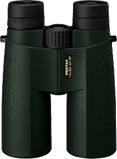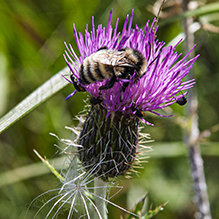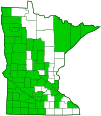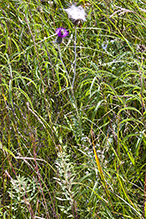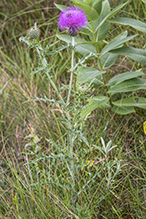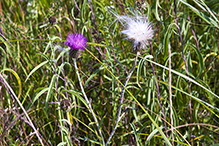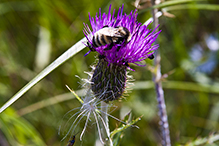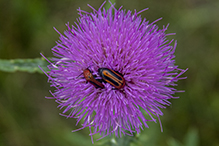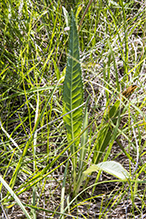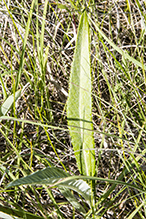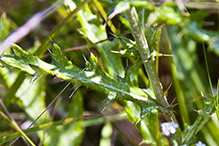Flodman’s thistle
(Cirsium flodmanii)
Conservation • Weed • Wetland • Description • Habitat • Ecology • Use • Distribution • Taxonomy
Conservation Status |
|||
| IUCN Red List | not listed |
||
| NatureServe | N5? - Secure SNR - Unranked |
||
| Minnesota | not listed |
||
Wetland Indicator Status |
|||
| Great Plains | FAC - Facultative |
||
| Midwest | FAC - Facultative |
||
| Northcentral & Northeast | FACU - Facultative upland |
||
Description
Flodman’s thistle is an erect, perennial forb. It can be 12″ to 55″ tall but usually reaches no more than 32″ in height. New plants rise usually on a single stem from short-lived, horizontal, creeping roots and eventually develop a taproot.
The stems are erect and slender, unbranched or with just a a few ascending branches above the middle. They are not winged and do not have spines. They are densely covered with short, white, matted or tangled, soft, woolly hairs (tomentose). As the plant ages the stem remains tomentose.
This plant first appears as a rosette of basal leaves. The basal leaves are inversely lance-shaped to narrowly elliptic in outline, up to 16″ long, and up to 4″ wide. They taper at the base to a winged leaf stalk. They are deeply lobed (pinnatifid), sometimes cut to the midrib. The lobes are triangular lance-shaped, sharply pointed, and seldom more than ¼″ wide. The upper surface of the leaf blade is light green or grayish-green and thinly tomentose at first, becoming hairless or nearly hairless with age. The lower surface is densely white tomentose, and remains so as it ages. The margins are coarsely toothed, spiny, and often rolled under. The first (outer) basal leaves may be unlobed but with spiny margins. The inner leaves become increasingly lobed. Basal leaves are usually absent at flowering time.
Stem leaves are similar, alternate, 1½″ to 16″ long, and ⅜″ to 4″ wide. Lower stem leaves are deeply pinnately divided into long triangular lobes are on winged leaf stalks. The leaves become smaller and shorter stalked but no less divided as they ascend the stem. Upper leaves are well developed and stalkless.
The inflorescence is a single flower head at the end of the stem and each branch tip. Sometimes a cluster of a few heads will rise from an upper leaf axil. The flower heads are stalkless or on up to 2″ long stalks which elevate them above the uppermost leaves. They are not subtended by a ring of spiny, leaf-like bracts.
The whorl of bracts at the base of the flower head (involucre) is egg-shaped to broadly bell-shaped, ¾″ to 1⅜″ long, 1″ to 1⅜″ wide, thinly covered with a few cobwebby hairs. They are rounded but not indented at the base. The bracts of the involucre have a 1 ⁄16″ to ⅛″ long, straw-colored spine at the tip, and a dark central zone and a light-colored, sticky ridge. The pale ridge is often called a racing stripe and is an identifying character of many thistles.
The flower heads are about 1″ wide with numerous purple, tubular, disk flowers.
The fruit is a light brown, ⅛″ to 3 ⁄16″ long achene (cypsela). The cypsela has a conspicuous yellow collar near the tip and a tuft of white hairs at the tip.
Height
12″ to 32″
Flower Color
Purple
Similar Species
Field thistle (Cirsium discolor) is a much taller plant, 36″ to 84″ in height. The stems become hairless or almost hairless with age. The upper leaf surface may be hairy but is never tomentose. The flower head is subtended by a ring of spiny, leaf-like bracts. The flower head is larger, 1½″ to 2″ wide. The collar on the cypsela is straw colored.
Habitat
Moderately moist. Meadows, pastures, fields, and railroads. Full sun.
Ecology
Flowering
June to September
Pests and Diseases
Use
Distribution |
||
|
Sources Biodiversity occurrence data published by: Minnesota Biodiversity Atlas (accessed through the Minnesota Biodiversity Atlas Portal, bellatlas.umn.edu, 10/25/2025). |
|
| 10/25/2025 | ||
Nativity |
||
Native |
||
Occurrence |
||
Common |
||
Taxonomy
Kingdom
Division
Tracheophyta (Vascular Plants)
Subdivision
Spermatophytina (Seed Plants)
Class
Order
Asterales (Sunflowers, Bellflowers, Fanflowers, and Allies)
Family
Asteraceae (Sunflowers, Daisies, Asters, and Allies)
Subfamily
Carduoideae (thistles and allies)
Tribe
Cardueae
Subtribe
Carduinae (thistles and burdocks)
Genus
Cirsium (plume thistles)
Tribe
Cardueae is a synonym of the tribe name. Cynareae was published first and has precedence. Nevertheless, most sources use the name Cardueae for the tribe.
Subordinate Taxa
Synonyms
Carduus flodmanii
Carduus oblanceolatus
Cirsium nebraskense var. discissum
Cirsium oblanceolatum
Common Names
Flodman’s thistle
prairie thistle
woolly thistle
Glossary
Achene
A dry, one-chambered, single-seeded seed capsule, formed from a single carpel, with the seed attached to the membranous outer layer (wall) only by the seed stalk; the wall, formed entirely from the wall of the superior ovary, does not split open at maturity, but relies on decay or predation to release the contents.
Axil
The upper angle where a branch, stem, leaf stalk, or vein diverges.
Bract
Modified leaf at the base of a flower stalk, flower cluster, or inflorescence.
Cypsela
A dry, one-chambered, single-seeded fruit, formed from a single carpel, with the seed attached to the membranous outer layer (wall) only by the seed stalk; the wall, formed from the wall of the inferior ovary and also from other tissues derived from the receptacle or hypanthium, does not split open at maturity, but relies on decay or predation to release the contents.
Involucre
A whorl of bracts beneath or surrounding a flower, flower head, or flower cluster.
Pinnatifid
Deeply cut, more than half way to the midrib but not to the midrib, into lobes that are spaced out along the midrib; the lobes do not form separate leaflets.
Tomentose
Densely covered with short, soft, matted or tangled, woolly, usually white or silvery hairs.
Wing
A thin, flat, membranous, usually transparent appendage on the margin of a structure.
Native Thistle Test
Thistles native to Minnesota do not have spiny stems. Grasp the stem near the base of any native thistle loosely in your fist, then slide your fist upwards to just below the inflorescence. If the plant is a native thistle, you will not get a single prickle – it will be “ouchless”.
If the thistle in question is thought to be an exotic (non-native) species, this test is not recommended.
Flodman’s thistle is native.
Visitor Photos
Share your photo of this plant.
This button not working for you?
Simply email us at info@MinnesotaSeasons.com.
Attach one or more photos and, if you like, a caption.
Dan W. Andree |
||
Dark Colored Bee...Whitish Face... I seen this bee and it caught my attention because of its color compared to other bees looked more solid and dark other than the face area. Could be some kind of Longhorn bee maybe? Since it has long antenna and a whitish or light area on the face. Interesting bee. It didn't hang around long but I did get a couple photos of it. |
||
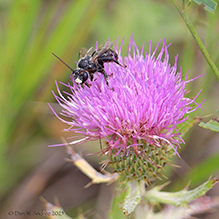 |
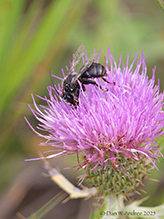 |
|

Regal Fritillary... A male Regal Fritillary on Flodman’s Thistle. Seen it on July 10, 2024. Beautiful butterfly. Hopefully more conservation programs will become available to help with the declining number. I never see many of them on any given year since I first noticed a regal fritillary between 5-6 yrs. ago but they declined in number in the few areas I seen any. The male regals life is pretty much done. Hadn’t seen any so imagine the few that were around have died off as it is that time of year for the male. Females haven’t seen any lately but haven’t been out much since the weather has been wet. I seen a few earlier in August but only a few. They gestate so to speak and need cover and rest etc. developing all the eggs. That is why they aren’t seen as much as some other species of butterflies. |
||
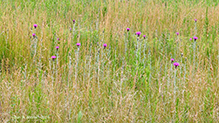 |
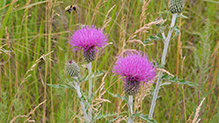 |
|
… Thistle... Noticed this stand of … thistle blooming. … They were maybe 2 to 3 feet tall. Several species of bees and insects seemed attracted to the flowers. |
Funny little Bumble Bee... Coming in for a landing on one of the flowering thistle at Frenchman’s Bluff SNA July 2024. This is a closer image of thistle out of the same group of thistle in the previous image sent of the several standing straight and fairly tall group. Funny little bumble bee. |
|
Luciearl |
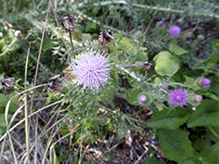 |
MinnesotaSeasons.com Photos

Slideshows
Cirsium flodmanii
Matt Lavin
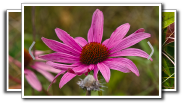
Visitor Videos
Share your video of this plant.
This button not working for you?
Simply email us at info@MinnesotaSeasons.com.
Attach a video, a YouTube link, or a cloud storage link.
Other Videos

Visitor Sightings
Report a sighting of this Plant.
This button not working for you?
Simply email us at info@MinnesotaSeasons.com.
Be sure to include a location.
Dan W. Andree
August 2025

Location: MN SNA, Norman Co. Mn.
I seen this bee and it caught my attention because of its color compared to other bees looked more solid and dark other than the face area. Could be some kind of Longhorn bee maybe? Since it has long antenna and a whitish or light area on the face. Interesting bee. It didn't hang around long but I did get a couple photos of it.
Dan W. Andree
7/23/2024

Location: Norman Co., Mn.
This 2024 season male regal numbers are down from last season in an area I usually see some. I’m not sure about females yet as they tend to remain in the dense vegetation until a little closer to the egg laying period which isn’t too far away really. I had seen a couple females back in July toward the last week but none since though I haven’t been out for about a week or so.
Also Jessica Peterson informed me the regals have been proposed for federal listing as threatened. So perhaps we will see some conservation actions directed at regals in the near future. I think that would be a good thing.
This female was down in some dense vegetation at a SNA in my area. I caught a little of her bluish sheen on the one wing. The light has to catch the wing areas just right for it to show. Early in their lives regals are a beautiful and a true native prairie butterfly. Real interesting species too.
Dan W. Andree
July 2024
MinnesotaSeasons.com Sightings
Blazing Star Prairie Addition Preserve, South Unit
Felton Prairie SNA, Bicentennial Unit
Margherita Preserve-Audubon Prairie
Mound Spring Prairie SNA, North Unit
Mound Spring Prairie SNA, South Unit
Northern Tallgrass Prairie NWR, Hoffman Unit
Northern Tallgrass Prairie NWR, Pavia Unit
Northern Tallgrass Prairie NWR, Rengstorf Unit
Northern Tallgrass Prairie NWR, Spieker Unit
Pankratz Memorial Prairie, North Unit
Pembina Trail Preserve SNA, Crookston Prairie Unit
Pembina Trail Preserve SNA, Pembina Trail Unit
Richard M. & Mathilde Rice Elliot SNA
